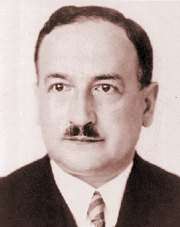
Selz was born on Feb. 14, 1881 in Munich, Germany to a well-off family. His father was a partner at a banking house and his mother’s father was a wealthy vinegar manufacturer. She came from a long line of Spanish Jews (ter Hark, 2010). Selz was a bright child, so bright in fact that “he was excused from the oral part of his final examinations in 1899″ (p.3).
At his father’s urging, Selz took a detour by studying law. But when he was admitted to the bar, Selz asked for his name to be removed. In 1909, he received his Ph.D in philosophy from the University of Munich. (It was entitled “The psychological theory of thinking and the transcendence problem.”)
According to this article in APA’s Monitor on Psychology, Selz’s research focused on “finding psychological answers to philosophical questions of consciousness.” From 1910 to 1915, Selz and his colleagues conducted experiments on problem solving. According to the article:
They asked participants to explain their problem-solving thought processes out loud as they tried to complete a task, such as finding a word related to but more generic than “newspaper” or “farmer,” such as “publication” or “worker,” respectively. The participants would explain how they identified the features of those words, how the features fit into larger categories and how the categories led them to new words.
From this series of studies, Selz concluded that participants were using a “schema” to direct their thinking process.
Based on these statements, Selz concluded that their minds were doing more than simply associating words and images they’d heard in conjunction before. To Selz, the participants were operating under what he called a “schema,” or an organizing mental principle, that guided their thoughts. Under this schema, the mind automatically orders relationships between ideas and can anticipate the connections among novel stimuli, serving as a basis for problem-solving. The existence of such an organized mental life would later become a cornerstone of the cognitive revolution.
Selz didn’t have many friends in psychology. In fact, he made several academic adversaries after criticizing their work. He vehemently disagreed with Gestalt psychologists’ top-down approach to problem solving. (According to the Monitor: “Gestaltists argued that a medley of perceptions can self-organize to form a solution, but that the perceptions themselves are meaningless without the solution. Selz instead argued for a bottom-up approach that recognized that these perceptions are like building blocks that the mind gradually learns to put together to form solutions.”) He made enemies of such psychologists as Narziss Ach and George Elias Mueller.
His work in Germany was cut short in 1933 when he was forced out of his position at the Mannheim Business School. The Nazis fired Jewish professors and prohibited other researchers from citing their work. After firing Selz, the Nazis sent him to Dachau for five weeks. After being released, Selz moved to the Netherlands where he continued his research. (The Nazis only let him go if he left Germany.) Here, he focused his work on improving educational methods. According to the Monitor:
Selz’s work on problem-solving was a natural fit for studying pedagogy and he began to devote his research to this area. Working with Dutch researchers, Selz sought to identify the specific cognitive skills that students used when performing a task, such as addition or subtraction, defining a word or comprehensive reading, and then to teach more advanced students to pass on those skills to struggling classmates.
Tragically, Selz’s work was cut short again when the Nazis invaded the Netherlands, and he was captured a second time. Selz’s colleagues did offer to hide him but he assumed that fighting in WWI for Germany and receiving an Iron Cross was enough to spare his life.
It wasn’t. In August 27, 1943, Selz died on the way to Auschwitz. It’s not clear how Selz perished (either from exhaustion, illness or the gas chamber). Computer scientists would later use his research for a new field called artificial intelligence.
For a more thorough look at Selz’s work and life, check out this article in the journal History of Psychology and the Monitor piece.
Reference
ter Hark, M. (2010). The psychology of thinking before the cognitive revolution: Otto Selz on problems, schemas and creativity. History of Psychology, 13, 2-24.
Photo courtesy of the Wikimedia Foundation.


Artículos Relacionados: